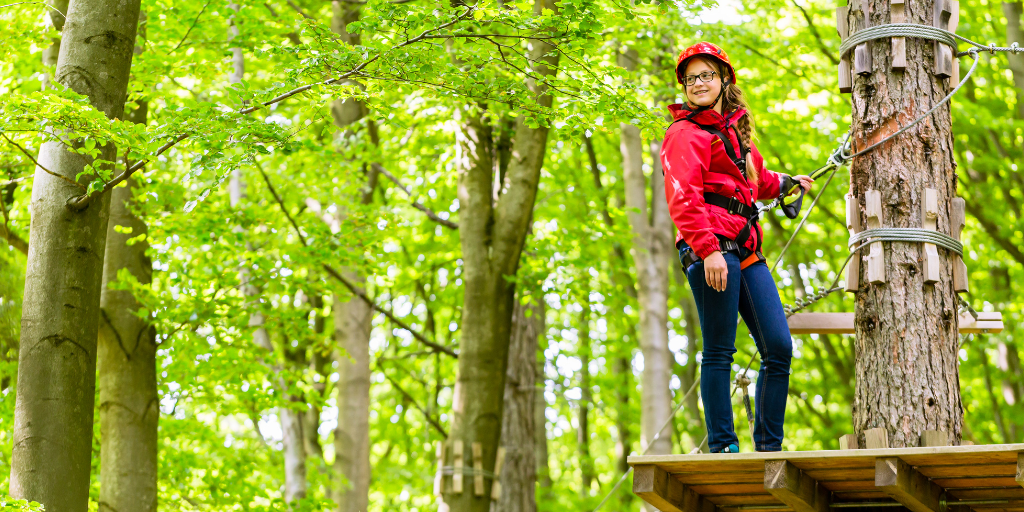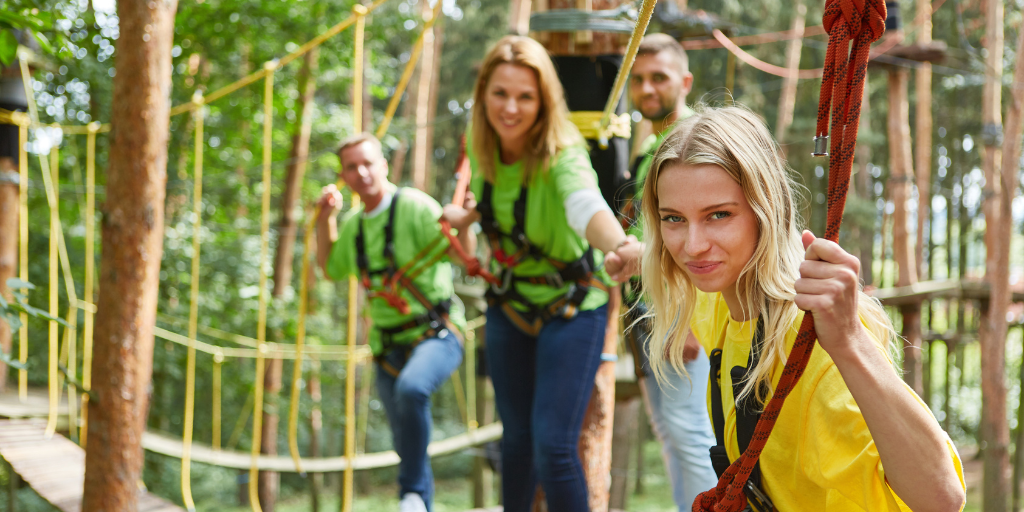Ropes Courses and Zipline Parks have gained immense popularity in recent years, offering exhilarating experiences to participants of all ages. Ensuring the highest level of safety is paramount for any aerial adventure park, which requires advanced rescue devices and well-trained staff. In this article, we explore various advanced rescue devices used in aerial courses, including harness systems, continuous belay systems, remote lowering systems, and emergency communication devices. We also discuss the importance of proper training and certification for rescue teams.
Many scenarios may require guests being rescued from the high rope course. These include anaphylactic shock caused by an insect bite, cardiovascular problems, or overexertion caused by overestimation. Evacuation, for example, due to a sudden storm, may also require rapid rescue. Using the rescue and abseiling device with lifting function is advisable in all these cases. This device can be used to lift people involved in an accident and then lower them to the ground in a controlled manner, where other rescue personnel will receive them.
Harness Systems: Providing Comfort and Security
Harness systems are the backbone of safety in aerial adventure courses. Modern harnesses are designed to provide maximum comfort and security for participants, while also ensuring ease of use for rescue teams. Some key features of advanced harness systems include:
- Full-body harnesses: These offer superior support and even distribution of weight, minimizing the risk of injury during a fall or rescue operation.
- Padding and adjustability: High-quality harnesses include adjustable straps and padding for a customized fit, ensuring participant comfort and proper weight distribution.
- Quick-release buckles: In the event of an emergency, quick-release buckles allow rescue teams to easily and safely detach participants from the course.
Continuous Belay Systems: Seamless Protection
Continuous belay systems are designed to ensure that participants remain connected to a safety line at all times, reducing the likelihood of accidental disconnection. Key components of continuous belay systems include:
- Carabiners and pulleys: These devices allow for smooth transitions between course elements and provide a reliable connection to the safety line.
- Trolley systems: Trolleys glide effortlessly along the safety line, enabling participants to traverse the course with ease while maintaining a secure connection.
- Automatic locking mechanisms: Advanced belay systems include automatic locking mechanisms that prevent participants from unintentionally disengaging from the safety line.
Remote Lowering Systems: Advanced Evacuation Solutions
In the event of an emergency, aerial adventure park staff must be equipped with advanced rescue devices that enable swift and efficient participant evacuation. Remote lowering systems offer the following benefits:
- Controlled descent: These systems enable rescue personnel to remotely control the speed of a participant's descent, ensuring a safe and controlled evacuation.
- Minimal physical strain: Remote lowering systems reduce the physical demands on rescue teams, enabling faster and more efficient evacuation operations.
- Versatility: These devices can be used in a variety of aerial adventure course settings, from zip lines to high ropes courses.

Emergency Communication Devices: Staying Connected in Crisis
Maintaining open lines of communication is essential during any emergency situation. Advanced communication devices used in Ropes Courses and Zipline Parks include:
- Two-way radios: These devices provide real -time communication between rescue teams and park staff, ensuring efficient coordination during emergency operations.
- Wireless communication headsets: Equipped with noise-canceling technology, these headsets allow rescue personnel to communicate clearly and effectively, even in noisy environments.
- Emergency call stations: Strategically placed throughout the course, these stations enable participants to directly contact park staff in case of emergencies.
Training and Certification for Rescue Teams
To maximize the effectiveness of advanced rescue devices, aerial adventure park staff must undergo comprehensive training and certification programs. Key elements of these programs include:
- Technical skills training: This encompasses the proper use of rescue equipment, such as harness systems, belay devices, and remote lowering systems, as well as best practices for evacuation procedures.
- First aid and CPR certification: Rescue personnel should be trained in first aid and CPR to provide immediate medical assistance to injured participants, if necessary.
- Scenario-based training: Realistic simulations of emergency situations help rescue teams develop the practical skills and decision-making abilities required during high-pressure rescue operations.
- Ongoing education: Regular refresher courses and updated certifications ensure that rescue personnel stay current with industry standards and technological advancements in rescue equipment.
Preventative Maintenance: Ensuring the Longevity of Rescue Devices
To maintain the optimal performance of advanced rescue devices, aerial adventure park operators must implement regular preventative maintenance practices. Some essential steps include:
- Visual inspections: Conducting daily visual checks of all equipment, including harnesses, belay systems, and communication devices, can help identify signs of wear, damage, or malfunction.
- Scheduled maintenance: Adhering to manufacturer-recommended maintenance schedules ensures the proper functioning of rescue devices and extends their service life.
- Equipment replacement: Establishing a replacement schedule based on usage and equipment lifespan helps to prevent potential equipment failure during critical rescue operations.
- Record keeping: Maintaining detailed logs of inspections, maintenance, and equipment replacements allows operators to track the condition of rescue devices and anticipate potential issues.
Industry Regulations and Standards: Upholding Best Practices
Aerial adventure parks must comply with industry regulations and standards to guarantee the highest level of safety for their guests. Some key guidelines and organizations include:
- ASTM International: The ASTM F2959 standard outlines safety performance specifications for challenge courses, canopy tours, and aerial adventure courses.
- PRCA (Professional Ropes Course Association): PRCA provides guidance on design, construction, operation, and inspection of Ropes Courses and Zipline Parks.
- ACCT (Association for Challenge Course Technology): ACCT offers standards for the installation, operation, and inspection of challenge courses, zip lines, and other aerial adventure facilities.
- ERCA (European Ropes Course Association): Association includes instructors, rescuers, trainers, builders and inspectors of ropes courses as well as organizations operating temporary ropes courses.
By adhering to these guidelines and working with reputable equipment manufacturers and training providers, aerial adventure park operators can ensure that their facilities meet the highest safety standards and provide unforgettable experiences for their guests.

Risk Management: Mitigating Hazards in Aerial Adventure Courses
Implementing a comprehensive risk management strategy is crucial for minimizing hazards and maintaining a safe environment in aerial adventure parks. Key elements of an effective risk management plan include:
- Site-specific risk assessments: Identifying and evaluating potential hazards unique to a specific aerial adventure park allows operators to implement targeted safety measures.
- Operational procedures: Establishing clear guidelines for daily operations, emergency situations, and staff training ensures consistent adherence to safety protocols.
- Staff training: As previously mentioned, investing in ongoing education and certification for rescue personnel is essential for maintaining a high level of safety and preparedness.
- Participant education: Providing participants with thorough safety briefings and instructions on the proper use of equipment can help reduce the likelihood of accidents or incidents.
By taking a proactive approach to risk management, aerial adventure park operators can create a safe and enjoyable environment for their guests while promoting a culture of safety and responsibility within their organizations.
Innovations in Rescue Devices: Embracing Technological Advancements
The aerial adventure industry is constantly evolving, and embracing technological advancements in rescue devices can further enhance safety and efficiency. Some notable innovations include:
- Smart belay systems: These advanced belay systems feature built-in sensors that detect when a participant is not properly connected to the safety line, preventing them from progressing until the issue is resolved.
- Drones for emergency response: In the event of an emergency, drones equipped with cameras and communication systems can quickly assess the situation, providing valuable information to rescue teams and reducing response times.
Future Trends in Aerial Adventure Course Safety
As the aerial adventure industry continues to grow and evolve, operators can expect to see emerging trends and advancements in safety technology and practices. Some potential developments include:
- Virtual reality training: Utilizing VR technology for rescue training can provide an immersive and realistic environment for staff to practice their skills, improving their preparedness for real-life emergency situations.
- Biometric monitoring: Integrating biometric sensors into harness systems or wearable devices could allow for real-time monitoring of participants' vital signs, alerting staff to potential health issues or distress.
- Predictive analytics: Leveraging data analysis tools to identify patterns and trends in equipment performance, participant behavior, and other factors can help operators proactively address potential safety concerns and continuously improve their safety protocols.
By staying abreast of these trends and incorporating emerging technologies into their operations, aerial adventure park operators can continue to provide exciting experiences for their guests while prioritizing safety and risk management.
Final Thoughts
Safety is the cornerstone of any successful aerial adventure park, and the use of advanced rescue devices, adherence to industry regulations, and investment in staff training and risk management are essential to maintaining the highest standards. As new technologies and trends continue to emerge, operators have the opportunity to further enhance safety measures and provide unforgettable, thrilling experiences for their guests. By prioritizing safety, aerial adventure park operators not only protect the well-being of their participants but also contribute to the growth and success of the industry as a whole.
Safety is of utmost importance in Ropes Courses and Zipline Parks, and advanced rescue devices play a crucial role in ensuring the well-being of participants. Harness systems, continuous belay systems, remote lowering systems, and emergency communication devices are essential components of a comprehensive safety infrastructure. Additionally, the proper training and certification of rescue teams are vital to the successful implementation of these devices and the overall safety of aerial adventure parks. By investing in advanced rescue equipment and well-trained staff, aerial adventure park operators can provide thrilling experiences for their guests while maintaining a strong commitment to safety.
Planning an Adventure project? Need expert advice on Adventure park design?
Get in touch today!
Additional expert information on the Adventure Business
Interested to read more about the Adventure Business with our expert articles?
- Logistics and throughput in Adventure Parks, key elements in Customer satisfaction
- Profitable Upgrades for Aerial Adventure Parks
- Integrating Gaming Technology into Adventure Parks
- Optimizing Adventure Park Operations: The Power of Predictive Analytics
- The Benefits of Integrating Urban Adventure Play in Commercial Retail
- Creating Profitable Adventure Parks: Tips and Strategies
- Roller Coaster Zipline: The Thrilling and Profitable Amusement Solution
- Prioritizing Safety: The Key to Success in Aerial Adventure Parks
- Maximize Your Adventure Park's Potential with an Online Reservation System
- Importance of a Safety and Quality Management System at Adventure Parks
- Virtual Reality Training in Adventure Parks: Revolutionizing Skill Development and Safety
- Climbing to New Heights: Boosting Traffic and Revenue with an Indoor Ropes Course
- How to Launch a Zip Line Company
- Ride a bike modified to attach to a zipline cable
- Adopting Universal Design and Adaptive Techniques for Inclusive Adventure
- From Skills to Thrills: How to Start and Run a Successful Adventure Business
- Thinking of investing and operating a Zipline? We got you covered with this expert article!
- Rope Course Construction: A Comprehensive Guide
- Leisure and Adventure in Retail Real Estate: The Future of Shopping
- The Benefits of Netted Attractions for Operators and Guests
- Thrills Adventure for Family Entertainment Centers’














